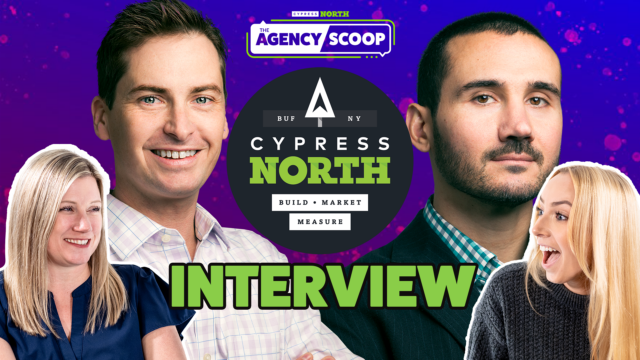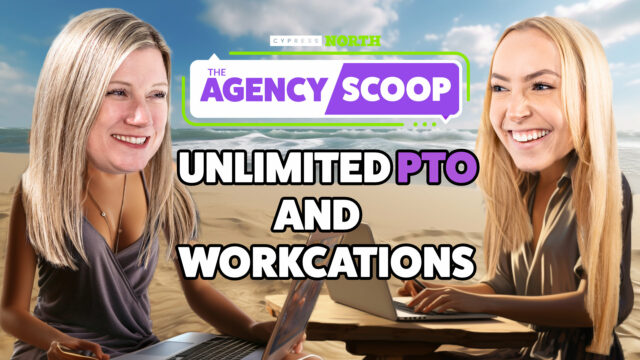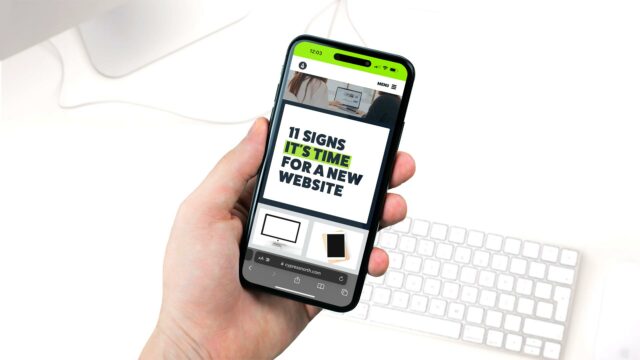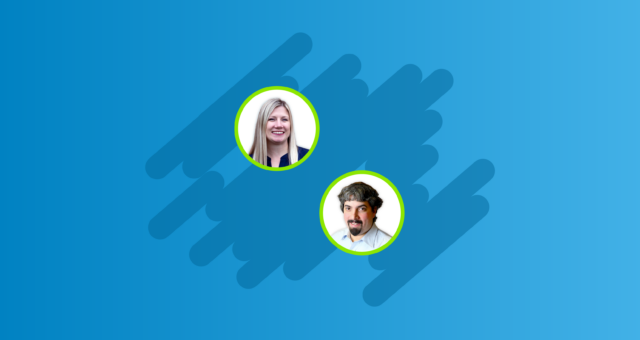Continuous Improvement Techniques for a Growth-Minded Agency

One of the things we pride ourselves on the most here at Cypress North is our growth mindset. If you’ve worked with us, you know that we’re always looking to test new things, learn from our experiences, and build on the success of our efforts. After all, it’s literally our job to be as efficient as possible with client resources (budget, time, and otherwise!) while driving the best results we can.

We believe that there’s no such thing as failure if you learn from it. If something doesn’t work, we pivot to find a new strategy that will drive results. If something works well, we ask ourselves what we can do to scale that win. This applies to client work, obviously, but we also like to practice what we preach internally. We take the time to reflect on our own processes and projects with continuous improvement in mind. This can be tough sometimes - not only because it often feels like talking about work means stepping away from said work that needs to be done, but also because it can be a challenging exercise to self-evaluate.
So how do we keep ourselves in check? Below we’ll dive into some of the tools we use and practices we follow to get better, as well as changes we’ve implemented as a result.
Tools for Growth
Our tactics for process improvement might seem obvious on paper, but as we’ve grown as an agency, we’ve seen incredible value in taking the time to gather feedback from our team (and our clients) to help us “do better next time.”
Using the following tools, we’ve been able to improve upon our approach to one-off projects, as well as ongoing work:
- Ongoing internal discourse
- Post-mortems and workshops
- Continual training
- Surveys and forms
Sounds simple, right? That’s because IT IS – as long as you take the time to do it. And I promise, it’s worth that time.
Even when we achieve great results, no effort goes off without a hitch. Taking the time to assess outcomes, and how we got to them, is essential for professional growth. It benefits individuals in their own career paths and makes for better workflows at the department and agency levels, all while improving client outcomes and satisfaction.
A happy, growing, efficient team is one that clients want to work with - and one they can work with confidently.
Our Process Improvement Tactics in Action
Let’s dig into some examples of how we put these tools to use.
Internal Communication That Fosters Productive Discourse
Something we do a lot around here is internal meetings. These come in many forms: agency-wide updates, work sessions that involve part or all of an account team, 1-on-1 conversations, group brainstorms, and open office hours.

Each serves its own unique purpose, but we don’t fill people’s calendars for the sake of simply holding meetings. We do our best to keep these efficient, quick, and productive.
How? Here are some tips:
- Carve out dedicated time and book it - if you find yourself saying, “we should talk about this,” make sure you do. Even if it’s a 15-minute slot, putting time in the calendar is a surefire way to ensure that important conversations happen.
- Don’t hesitate to cancel - once you book that slot, feel free to skip or reschedule for later if there’s nothing to discuss at the dedicated time. People love getting time back!
- Develop a good cadence - if regular meetings are in order, make sure they’re scheduled at an appropriate frequency. Projects with a lot of moving parts and more complex accounts may require weekly meetings to keep everyone on track, while check-ins on slow-moving efforts and vibe-checks with individuals might make sense to do monthly. Make sure there’s enough time between meetings for people to work on their stuff so that the next meeting is actually productive. Do what makes sense and adjust according to changes throughout.
- Come with an agenda - whether it’s a formal document or not, whoever is leading the meeting should show up with a list of things to discuss. Ask your team to do the same. This will streamline the conversation, make sure everyone’s concerns are heard, and give you something to refer back to post-meeting.
- Action that sh*t - do your best to delegate follow-up tasks during the meeting. If everyone walks away knowing what they need to do next, you’ll save time and everyone can get right to it.
- Encourage others to give input - don’t skimp on room for back and forth. Internal meetings are a great venue for finding solutions! Use the time to work through the best way to tackle a problem, brainstorm ideas for new initiatives, and open the floor for people to speak to roadblocks and challenges they’re facing in their own work.
- When it’s over, it’s over - we’ve seen some great conversations happen as folks filter out of a meeting. While it’s important not to stifle discourse, context is lost if it occurs once some people have left the room. Close out every meeting with, “Does anyone have anything else to discuss?” to give that opportunity ahead of time. If necessary, call another meeting for anything that comes up later.
Not only is it important from a personnel perspective to make your team feel heard, but it’s also critical to remember that they might need encouragement to voice when they have something to say. 🙋♀️ Taking the time to facilitate this cannot be undersold.
Internal conversations have been a main driver of positive change at our agency, and are the catalyst for the use of many of the other tools we rely on for continuing to improve our processes and quality of work.
Post-Mortem Meetings & Workshops
An internal meeting format we leverage for process improvement here at Cypress North is the post-mortem. Sounds morbid, but in actuality, these have been some of the most upbeat and valuable meetings we’ve had.
What is a post-mortem meeting?
It’s just a meeting of the minds once a project is over in which we:
- Assess how it went overall
- Talk about what went well from a process standpoint
- Address any pain points we may have encountered
- Brainstorm ideas for how to better execute a similar project next time

We piloted this exercise after a website launch we completed which was particularly difficult for our team due to several factors (not being the only vendor, a very aggressive timeline, and a new project manager, to name a few.) What started as a much-needed venting session for the team evolved into a highly productive conversation about our own website process in general, and what we could improve upon internally for a smoother workflow. We made note of things that could help us with similar projects in the future, and have since iterated further upon that initial chat.
Changes we’ve implemented have improved our own internal efforts and made things easier for clients. Examples include:
- Increased speed and lower friction between project stages by increasing communication between departments to better understand expectations and capabilities
- Faster turnaround time on deliverables by involving all team members whose work is impacted by decisions made at previous stages, providing much-needed context and a deeper understanding of the goals at each stage
- Decreased meeting bloat and redundant communication by using tools such as Loom to provide shareable explainer videos rather than one-time presentations via Zoom
- Reduced rounds of feedback by getting key stakeholders involved earlier in the process
This worked so well that someone on our team suggested having a post-mortem after a particularly difficult project we completed on the marketing side. (In fact, this was an ask that came out of a 1-on-1 I had with a team member - see?!)
The particular project was one that was very unique in nature and that we likely weren’t going to replicate again. But given the obstacles our team faced in doing it, we figured there would still be some learnings we could take away from it that could be applied elsewhere.
And boy were we right!
In chatting with our team, we uncovered room for efficiencies with project management, shortcomings with ChatGPT and how to work with (and around) them, and even a general need for developing internal style guides for all clients that account for feedback, voice, etc. A great resource to have, and certainly an AHA! moment.
The best part? We ended up being awarded a very similar contract just a month or so later. This time around, we took the feedback from our team and applied it directly to the proposal - accounting for a more realistic timeline, better cadence for feedback, and setting expectations for deliverables on both the client and agency side of things.
Given the new parameters, a project that was very difficult and frustrating for our team the first time became something several people volunteered for (with a smile!) the next time around. And I’m happy to report that as I write this, we’re in the thick of it, and it’s going swimmingly. The client is happy, and our team is happy.
Love 👏 to 👏 see 👏 it.
For ongoing efforts, there can’t exactly be a post-mortem, but holding workshops in a similar vein can accomplish the same thing. We practice this too.
Training Sessions
Given the constant changes in our industry, training is a crucial element for professional development within our marketing department. We hold training sessions several times a week, diving into various topics. Sessions have always been insightful, but we recently realized they’d all been following the same format, which was starting to feel stagnant with our growing team. So we decided to revisit our strategy.
Different people have different learning styles, and we need to support that. With a large group of marketers at various points in their careers, across offices in two cities, representing a wide variety of skill sets, we wanted to check in with the team and see what they thought about our current training efforts.

The goal was to meet and talk about what people find the most valuable, what they’d like to see more (or less) of, and whether the format in which we conduct training is giving people the education they need. In short, how could we make sure everyone gets as much out of the sessions as possible - especially with the limited time available in a workday?
Not only did the team have a lot of great ideas for how to shake things up, but we also heard from a lot of folks who wanted to volunteer their expertise and offer to lead a training of their own!
Engagement, investment, and constructive criticism from the bottom up. Talk about a manager’s dream! 🤩
We’ve since made some changes to better meet the needs of our team, and still have room to grow. If you’re looking for some inspiration for your own team, some general themes we’ve picked up on and implemented that might help you:
- Distraction-free environments matter - for presentation-style training, everyone used to sit at their desk and attend via Zoom; making it easy for folks’ attention to be diverted by email, Slack messages, phone calls, etc. We now fire up the presentation on a TV in collaborative spaces and rally the troops to get up (good for the body anyway) and sit together. Not only are they paying closer attention, but we see increased camaraderie and do a lot more laughing together.
- In-person works well for smaller groups - for those looking to increase participation, holding training sessions in person is a huge benefit. Folks feel freer to interject with questions and it’s also easier for the person leading the training to get a sense of their audience and cater the material to the vibe.
- Variety is the spice of life - we heard from our team that presentations are helpful for broader concepts and demonstrating basic platform execution, but that they’d also like to see specific problems, solutions, and the results outlined more like a live, interactive case study. They also enjoy diving in and performing exercises themselves, with someone there to help guide them along the way - learning by doing.
We’ll be collecting feedback again in a few months to see how the changes have impacted our team’s ability to learn, and will continue to iterate from there. There’ll be another group workshop, yes, but we’re also going to be launching an internal survey that will allow everyone to submit feedback anonymously (or not) about the 1-on-1 training they’re receiving, their own learning styles, and give more specific details about what matters to them from a growth perspective.
Surveys & Forms - Collecting Critical Information Up Front
Speaking of surveys… when we reflect upon our internal processes, we often survey the team (often informally) for pain points in working cross-departmentally. While we’re a tight-knit team, there’s a difference between chatting over coffee in the morning and asking someone outside your team to do something for you.
As marketers, we work with all of our other departments (creative, data, and dev) in order to support our clients’ needs, and sometimes requests get lost in translation. We just don’t always speak the same language, because we do very different things.
How do we eliminate friction and confusion so we can focus on the task at hand? One tool we find useful is forms. Whether a Google Form or a fill-in-the-blanks style document, intake forms have been a huge improvement for our internal workflows.

For example, our design team gets hit with ad creative requests all day long. If they don’t work on an account regularly, it’s difficult for them to design something impactful without all of the information as to why we’re creating said piece. What is the end goal? What action are we looking for the user to take? Where will the ad be displayed? What can - and more importantly, can’t - we say?
Answering those questions upfront not only helps our designers come up with enticing, performance-based ads, but it also speeds up the process by eliminating the need for a meeting and often eliminating rounds of revisions before the client ever even sees the thing.
Despite our best efforts, we are not mind-readers. So we asked our creative team what they needed from us in order to do their best work. They developed a simple form that forces our marketing team to think through the details before making a request to supply those ahead of time. If they need more context, they will ask, but they’re coming into the conversation with essential background knowledge, and even some ideas, already. This makes for a far more productive conversation and eliminates unnecessary back-and-forth about details that should be clear from the start.
Faster turnaround internally means campaigns get launched more quickly, and clients always appreciate that! 💨
Never Be Stagnant
And there you have it! Without giving away too much of the secret sauce, that’s how your team at Cypress North is constantly iterating and working to grow in efficiency for better results for our clients, and for ourselves.
Want to put our continuous improvement mindset to work for you? Let us know how we can help!
Curious, ambitious, and on the job hunt? Join our team of growth-minded folks!
Meet the Author

Jess Budde
Jess is our Director of Marketing Operations & Client Services, and a co-host on our weekly Marketing O’Clock podcast. She joined Cypress North in 2013 and works out of our Buffalo office.
Jess serves as a liaison between internal and external teams, collaborating closely with both to cultivate successful client-agency relationships. She oversees all relationships from the very beginning, facilitating the sales process and proposals, managing contracts, and onboarding. She continues to act as a point of contact to ensure we’re providing the best experience and results for all clients.
Beyond client services, Jess is a performance marketing generalist with expertise in both paid and organic strategy. In previous roles as a senior marketing manager, she led some of our largest client accounts, driving results with PPC campaigns, lead nurturing, and organic content.
For more than a decade, Jess has been a trusted voice and thought leader in the digital marketing community, keeping clients and colleagues alike updated on the news that impacts them via the Marketing O’Clock podcast.
Jess is a Western New York native and graduated with a Bachelor of Arts in communication studies from Niagara University before attending Syracuse University, where she earned her Master’s degree in television, radio, and film. Prior to joining Cypress North, she worked in series development, talent, and casting at MTV during the golden Jersey Shore era.
When Jess isn’t working or giving takes on the latest digital marketing news, she enjoys spending time outside, hanging out with her two beautiful children, and watching the entire Sons of Anarchy series on repeat. You may also find her slinging beers at Brewed & Bottled, the craft beer shop and bar she runs with her husband.
Jess is an amateur ornithologist, Limp Bizkit lover, Candy Crush professional, and hot sauce connoisseur who enjoys burning herself into oblivion with the hottest sauce she can find.





















